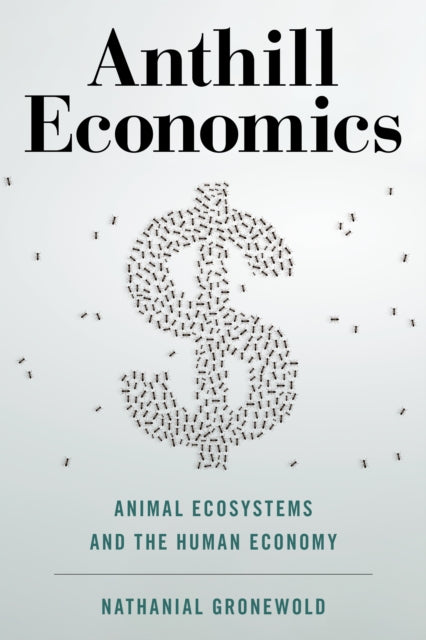Nathanial Gronewold
Anthill Economics: Animal Ecosystems and the Human Economy
Anthill Economics: Animal Ecosystems and the Human Economy
YOU SAVE £5.72
- Condition: Brand new
- UK Delivery times: Usually arrives within 2 - 3 working days
- UK Shipping: Fee starts at £2.39. Subject to product weight & dimension
Bulk ordering. Want 15 or more copies? Get a personalised quote and bigger discounts. Learn more about bulk orders.
Couldn't load pickup availability
- More about Anthill Economics: Animal Ecosystems and the Human Economy
In his book "Anthill Economics," Nathanial Gronewold argues that biophysical laws are fundamental to the global economy and that understanding these laws can help us better understand human demographics, population patterns, and economics. He uses ecological analogies to demonstrate how biophysical principles can be applied to the global economy, such as the behavior of caribou populations, squirrels, and ants.
\n Format: Hardback
\n Length: 208 pages
\n Publication date: 05 May 2021
\n Publisher: Prometheus Books
\n
The fundamental laws of physics are the bedrock upon which modern economic theory is built. However, there is growing evidence that the current economic model, which is based on the principles of supply and demand, may be insufficient to explain the complex dynamics of the global economy. In his book, Anthill Economics, award-winning environmental and energy writer Nathanial Gronewold explores the question of whether modern economic theory violates some of these fundamental laws.
Gronewold argues that the modern school of economics is missing a crucial component: energy. While oil, natural gas, and wind power are important sources of energy, they are only a small part of the broader picture. The true essence of energy is its ability to transform matter into food, shelter, and material possessions. Ecologists have been using the principles of biophysics to study ecosystems for centuries, and Gronewold suggests that these same principles can be applied to the global human economy.
At its core, the global economy is simply humanity's ecosystem. Just as ecosystems are governed by biophysical laws such as population density, energy return on investment, and habitation patterns, so too is the global economy. Gronewold uses a range of examples, from the rollercoaster-like rise and fall of caribou populations on a remote island to the behavior of squirrels gathering nuts, to illustrate how biophysical laws can teach us about resource allocation, global inequality, and economic energy return on investment.
One of the most intriguing aspects of Anthill Economics is its assertion that biophysical laws are just as fundamental to the global economy as they are to zoology and entomology. Gronewold draws on the work of scientists who have studied the behavior of ants and other insects to demonstrate how their patterns of movement and behavior can be applied to human traffic patterns and the daily pulse of ants in the forests. He suggests that human traffic patterns may mimic the daily pulse of ants in their central business districts, and that global warming may change these patterns for humans and insects alike.
Gronewold's book is written in a clear and accessible style, full of illuminating ecological analogies that give readers an informed and entertaining introduction to the cutting-edge field of biophysical economics, also known as thermoeconomics. Thermoeconomics seeks to provide a more complete understanding of the global economy by incorporating the principles of thermodynamics, which study the relationship between energy, heat, and work. By understanding the relationship between these three components, thermoeconomics can help us to better understand the economic implications of climate change and other environmental challenges.
In conclusion, Anthill Economics is a thought-provoking and innovative book that challenges the current economic model and suggests that biophysical laws may hold the key to understanding the global economy. By incorporating the principles of thermodynamics, Gronewold provides a radical new way of looking at the world and offers a glimpse of a more sustainable and equitable future. While the book may not provide all the answers, it is a valuable contribution to the ongoing debate about the future of the global economy and the role of science in shaping it.
\n Weight: 460g\n
Dimension: 164 x 236 x 25 (mm)\n
ISBN-13: 9781633886520\n \n
This item can be found in:
UK and International shipping information
UK and International shipping information
UK Delivery and returns information:
- Delivery within 2 - 3 days when ordering in the UK.
- Shipping fee for UK customers from £2.39. Fully tracked shipping service available.
- Returns policy: Return within 30 days of receipt for full refund.
International deliveries:
Shulph Ink now ships to Australia, Belgium, Canada, France, Germany, Ireland, Italy, India, Luxembourg Saudi Arabia, Singapore, Spain, Netherlands, New Zealand, United Arab Emirates, United States of America.
- Delivery times: within 5 - 10 days for international orders.
- Shipping fee: charges vary for overseas orders. Only tracked services are available for most international orders. Some countries have untracked shipping options.
- Customs charges: If ordering to addresses outside the United Kingdom, you may or may not incur additional customs and duties fees during local delivery.


